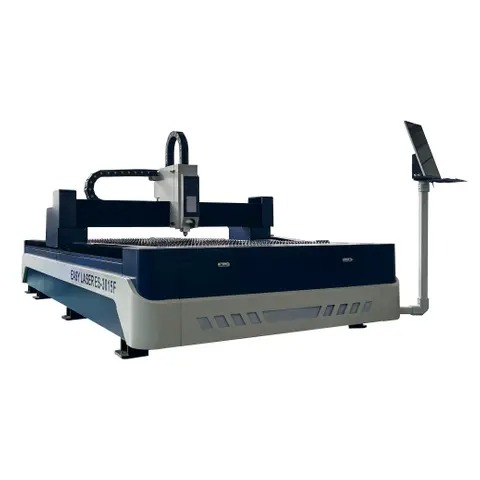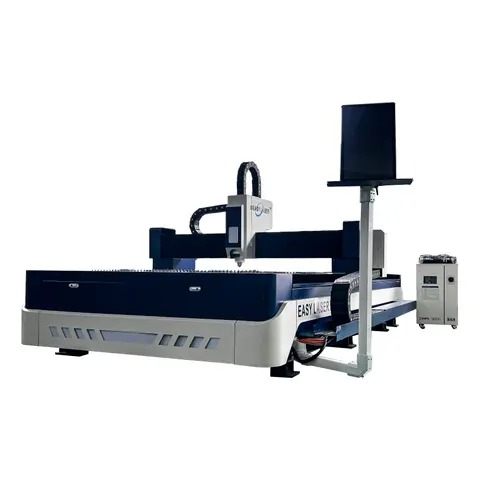Views: 179 Author: Site Editor Publish Time: 2025-07-12 Origin: Site
In today's fast-evolving industrial landscape, precision, efficiency, and automation are no longer luxuries—they are necessities. Among the many innovations shaping the future of manufacturing, the fiber laser cutting machine stands out as a transformative tool that redefines what's possible in metal cutting. But how does it actually outperform traditional cutting methods such as plasma, oxy-fuel, or mechanical shearing? Let's explore the advantages of fiber laser cutting in depth and understand why it's quickly becoming the go-to solution for modern fabrication facilities.
One of the most significant advantages of fiber laser cutting machines lies in their unmatched precision and edge finish. Traditional methods such as plasma or flame cutting often leave behind rough edges, dross, or require post-processing to smooth the surface. In contrast, fiber lasers generate a highly focused beam of light that can be as narrow as 0.1 mm, allowing them to achieve micron-level accuracy even on the most intricate designs.
Fiber lasers are also capable of minimizing thermal distortion, as the heat-affected zone (HAZ) is very small. This reduces the likelihood of material warping, which is a common issue in conventional thermal cutting techniques. Furthermore, fiber lasers can easily manage complex geometries and sharp internal corners without the need for additional tooling or manual intervention.
The precision offered by fiber lasers is especially critical for industries like aerospace, medical device manufacturing, and electronics, where even the slightest deviation from the design can lead to functional defects or compliance issues. This level of accuracy ensures not only higher product quality but also greater consistency in high-volume production runs.
When compared to traditional cutting methods, fiber laser cutting machines offer significantly faster cutting speeds, especially for thin to medium sheet metals such as stainless steel, aluminum, and carbon steel. While plasma cutting can be relatively fast for thicker materials, it struggles to keep up with the speed and precision of fiber lasers on thinner gauges.
For instance, a 3kW fiber laser can cut 1mm stainless steel at speeds exceeding 30 meters per minute, while a similar power plasma cutter might achieve less than half that rate. This acceleration translates into substantial productivity gains, particularly for operations that rely on high throughput or deal with tight production schedules.
Additionally, fiber lasers can transition rapidly between cutting tasks, often without requiring significant downtime for tool changes or recalibration. This agility is crucial for contract manufacturers or job shops handling a diverse range of components and custom orders.
The use of automation further enhances the productivity of fiber laser cutting machines. Many modern systems integrate automatic material loading, part nesting software, and real-time monitoring capabilities, enabling 24/7 operation with minimal human supervision.

While the initial investment in a fiber laser cutting machine may be higher than some traditional methods, its long-term cost benefits are indisputable. First, fiber lasers are inherently more energy-efficient. They convert over 30% of input electrical energy into laser light, whereas CO₂ lasers typically achieve only 10–15%. Compared to plasma and oxy-fuel cutting, the energy savings become even more pronounced.
Second, fiber lasers do not require consumables like gas mixtures or electrode tips, which are essential in plasma and flame cutting. This eliminates recurring costs and reduces the complexity of machine maintenance. The solid-state design of fiber lasers also ensures fewer moving parts, resulting in less wear and tear, longer operational lifespans, and minimal maintenance downtime.
Moreover, since fiber lasers generate minimal waste and have excellent material utilization rates, manufacturers can reduce scrap and improve their bottom line. Over time, the total cost of ownership (TCO) of a fiber laser system often proves to be much lower than that of conventional cutting equipment.
Fiber laser cutting machines are incredibly versatile, capable of handling a wide range of materials with varying thicknesses. While traditional methods like oxy-fuel are largely restricted to cutting ferrous metals and struggle with reflective materials, fiber lasers can process:
Stainless steel
Mild steel
Aluminum
Copper
Brass
Titanium
High-strength alloys
This capability is largely due to the wavelength of fiber lasers (usually around 1.06 μm), which is more efficiently absorbed by reflective metals compared to the longer wavelengths of CO₂ lasers. As a result, fiber lasers can cut non-ferrous and coated metals without damaging the optical components or requiring special gases.
Furthermore, fiber lasers are equally effective in cutting, marking, engraving, and even welding applications, making them a multi-functional tool in any fabrication shop. Their precision and speed make them suitable for everything from intricate jewelry to heavy machinery components.
Safety is always a top priority in any manufacturing environment. Traditional methods like oxy-fuel and plasma cutting expose operators to risks such as open flames, high temperatures, toxic fumes, and ultraviolet radiation. Mechanical cutting involves direct contact, posing risks of mechanical injury.
Fiber laser cutting machines, on the other hand, are designed with safety enclosures, automatic shut-off sensors, and fume extraction systems that mitigate these risks. Operators can interact with the machine through user-friendly software interfaces and remain protected from direct exposure to the cutting process.
From an environmental perspective, fiber lasers also have a smaller ecological footprint. They consume less power, emit fewer pollutants, and generate minimal waste. By reducing the use of consumables and avoiding chemical coolants or cutting oils, fiber lasers contribute to cleaner, more sustainable production practices.
In regions with strict environmental regulations or corporate sustainability goals, fiber laser technology helps businesses remain compliant while enhancing their green credentials.

| Feature | Fiber Laser Cutting Machine | Plasma Cutting | Oxy-Fuel Cutting | Mechanical Shearing |
|---|---|---|---|---|
| Cutting Speed (Thin Metal) | Very High | Moderate | Low | Low |
| Precision & Edge Quality | Excellent | Moderate | Poor | Good |
| Material Versatility | High (even reflective metals) | Limited | Only ferrous metals | Limited |
| Energy Efficiency | High | Low | Low | Moderate |
| Safety | High (enclosed system) | Moderate | Low | Low |
| Operating Cost | Low (long-term) | Moderate | High | Moderate |
| Maintenance | Low | High | High | Moderate |
Yes, high-power fiber lasers (6kW and above) can efficiently cut metal sheets up to 25–30 mm thick, depending on the material. However, for extremely thick plates, plasma or flame cutting might still be more economical.
Modern fiber lasers come with intuitive software and CNC controls, making them user-friendly even for less experienced operators. Training requirements are minimal compared to older systems.
Fiber lasers are low-maintenance machines. Routine checks on optics, filters, and cleanliness are typically sufficient. The absence of consumables further simplifies upkeep.
Absolutely. Systems can be configured with auto-loading units, camera-based alignment tools, and material sensors to suit specific production workflows.
In conclusion, the advantages of using a fiber laser cutting machine over traditional cutting methods are clear and compelling. From precision and productivity to safety and sustainability, fiber lasers redefine the standards of metal fabrication. They empower manufacturers to meet rising demands for quality, speed, and cost-effectiveness—all while future-proofing their operations against evolving industrial challenges.